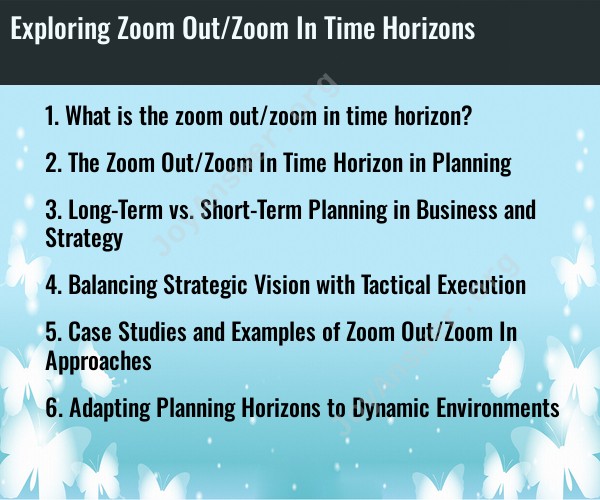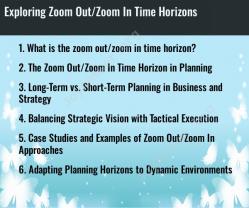What is the zoom out/zoom in time horizon?
The "zoom out/zoom in" time horizon is a strategic planning and decision-making concept that involves considering issues and strategies at different levels of detail and time frames. It is often used in various fields, including business, project management, and long-term planning. The idea is to switch between a broad, high-level perspective (zooming out) and a more focused, detailed perspective (zooming in) to better understand and address complex problems and make well-informed decisions. Here's a breakdown of the concept:
Zoom Out (Broad Perspective):
- When you "zoom out," you take a step back and look at the big picture. This involves considering long-term goals, overarching strategies, and high-level objectives. You're looking at the larger context in which you're operating.
- In a business context, zooming out might involve thinking about a company's mission, vision, and long-term growth strategies. In project management, it might involve examining the project's overall objectives and alignment with organizational goals.
Zoom In (Detailed Perspective):
- When you "zoom in," you focus on specific details, short-term actions, and immediate tasks. This involves getting into the nitty-gritty of how to implement the strategies and achieve the goals identified when zooming out.
- In a business context, zooming in might involve tactical planning, such as developing marketing campaigns, setting quarterly targets, or managing day-to-day operations. In project management, it could mean defining project tasks, timelines, and resource allocation.
Iterative Process:
- The zoom out/zoom in process is often iterative. After zooming out and defining high-level strategies, you may need to zoom in to break those strategies down into actionable steps. Conversely, when you're immersed in the details, you may periodically zoom out to ensure you're still aligned with the big-picture goals.
Problem Solving and Decision-Making:
- This approach is valuable for complex problem-solving and decision-making. It allows you to explore multiple levels of detail and time horizons, ensuring that your decisions are well-informed and aligned with your long-term objectives.
Flexibility and Adaptability:
- The ability to zoom in and out as needed makes your approach flexible and adaptable. It allows you to respond to changing circumstances and refine your strategies as new information becomes available.
The zoom out/zoom in time horizon is a tool for balancing the need for long-term vision and short-term execution. It helps prevent the tunnel vision that can occur when only focusing on the details, and it prevents losing sight of the big picture when only considering long-term goals. By incorporating both perspectives, individuals and organizations can make more holistic and effective decisions.
Sure, here is a detailed explanation of the five topics you mentioned:
The Zoom Out/Zoom In Time Horizon in Planning
The zoom out/zoom in approach to planning is a strategic framework that emphasizes the importance of considering both long-term and short-term goals simultaneously. It involves shifting between a "zoom-out" perspective, focused on long-term vision and strategic direction, and a "zoom-in" perspective, focused on immediate actions and tactical execution.
Long-Term vs. Short-Term Planning in Business and Strategy
Long-term planning involves defining overarching goals, identifying strategic opportunities, and developing a roadmap for achieving those goals over an extended period, often 5-10 years or more. It focuses on shaping the future direction of the organization and ensuring its long-term sustainability and competitive advantage.
Short-term planning, on the other hand, focuses on achieving specific objectives and implementing tactical initiatives within a shorter timeframe, typically 1-2 years. It involves allocating resources, managing day-to-day operations, and making decisions that contribute to the achievement of immediate targets.
Balancing Strategic Vision with Tactical Execution
The zoom out/zoom in approach emphasizes the need to balance strategic vision with tactical execution. It encourages organizations to not only define long-term aspirations but also translate those aspirations into actionable steps and measurable milestones.
This approach helps organizations avoid getting caught up in theoretical planning or becoming too focused on short-term firefighting. It promotes a dynamic and adaptable planning process that aligns long-term goals with near-term actions.
Case Studies and Examples of Zoom Out/Zoom In Approaches
Companies like Google, Amazon, and Apple have successfully employed the zoom out/zoom in approach to achieve remarkable growth and innovation.
Google's "20% time" policy, allowing employees to dedicate 20% of their work time to personal projects, exemplifies the zoom-out mindset, encouraging exploration and innovation.
Amazon's focus on customer satisfaction and continuous improvement illustrates the zoom-in mindset, driving operational efficiency and customer-centric initiatives.
Apple's seamless integration of hardware, software, and services demonstrates the balance between long-term vision and tactical execution, creating a cohesive product ecosystem that appeals to consumers.
Adapting Planning Horizons to Dynamic Environments
In today's rapidly changing business landscape, the zoom out/zoom in approach is particularly relevant. Organizations need to adapt their planning horizons to the dynamic nature of their industry, market, and technology advancements.
The zoom-out perspective helps organizations identify emerging trends, anticipate disruptions, and prepare for future challenges.
The zoom-in perspective ensures that organizations remain agile and responsive, adapting to immediate changes and executing short-term initiatives that support long-term goals.
By effectively employing the zoom out/zoom in approach, organizations can navigate the complexities of the business world, achieve sustainable growth, and maintain a competitive edge.


